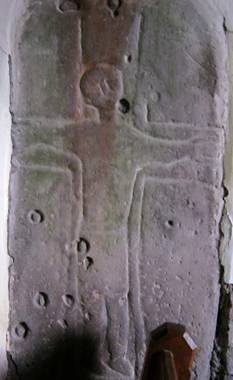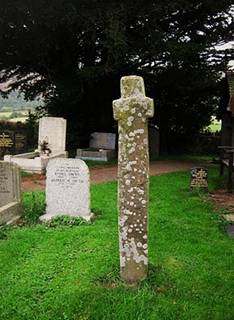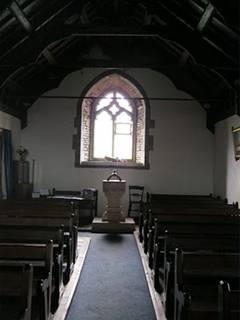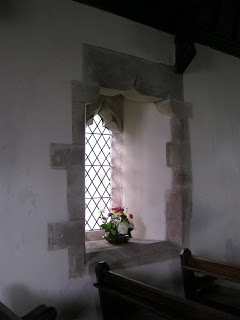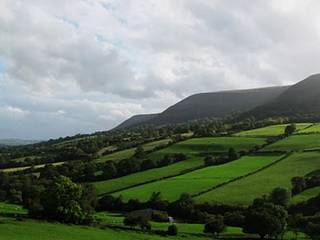Title: | Guest Contribution: Llanfueno – Saint Bueno of Wales and his Mountain School |
Date: | c 450 - 2010 |
Guest Contribution: Introduction
The article below was written by Eve Nicholson and first published on her internet blog ‘Mary in Monmouth ’. It is reproduced here from that source with our grateful acknowledgement
Ewyas Lacy Study Group
LLAN FEUNO - SAINT BEUNO OF WALES and his MOUNTAIN SCHOOL
|
| The story of Llanveynoe begins in the area of Newport and St Woolos (known to all as St Gwynlliw's). Bugi ap Gwynlliw was the last of the children of St Gwynlliw, the 'pirate' saint of what is now 'Stow Hill' and the Saintly Gwladys, daughter of the great King Brychan Brycheiniog, who had been carried off by Gwynlliw, when he was sick for love of her and had the whole court of Brychan chasing after him. Battle was avoided when Gwynlliw married her, and according to the will of God, her children were like her, great saints of Gwent. The 'Baby' of the family, her youngest and adored son, Bugi, was educated, like his elder brother Cadoc at Caerwent with St Tatheus |
|
| Bugi was also, in Welsh known as HYWGI and was one of the four patron saints of the monastery of LLANGWM near Usk, where he may have done his formation as a monk and priest. When he was old enough to marry, he took for a wife Princess Peren, daughter of the King of Llawden, and then went up to Powys to be nearer to Bugi's grandfather's court. It seems that Peren became a mother to their only son late in life, a son called BEUNO and this son too, was educated at Caerwent with St Tatheus and taught the Christian faith. Since Tatheus was inspirational, particularly to St Cadoc and a father figure to them all Beuno, like his uncle Cadoc, decided |
to follow the Mission and spread it into North Wales, which was still steeped in pagan lore, where there had been no missionary zeal as yet to evangelise the Mission (Mass) of Christ, to go out into all the world and preach the gospel and baptising them in the name of the Father, Son and Spirit. There were some hybrid Druid/Christian communities, which were actually Druid Communities and looked the same in appearance, yet were actually maintaining Druid customs and philosophy and missing the real point of the Christian teaching. This was possible as there were a number of similar points in the philosophy, which had been used to bring Druids to faith. On leaving Caerwent it seems Beuno decided to found his own Llan not far from that of his parents. He would have had his twelve fellow monks to help and they came to this district of Llanveynoe, which is in one of the most beautiful and remote areas of the Black Mountains.
The land at Ewias was given to him by King Ynyr Gwent, King of Gwent (husband of St Materiana of Cornwall who observed Beuno was 'humble, chaste and generous and in every respect keeping the commandments of God’.
Beuno was also a kinsman of St Kentigern, (Mungo). It was more likely the land given to him was by Iddon, son of Ynyr, however, as a devastating raid on their camp near Chepstow by Saxons killed Ynyr, 'torched' the camp and sent his mother (Madryn-St Materiana) and brother St Ceidio to Boscastle in Cornwall on their White Martyrdom.
The other lands were Ewyas Leol, and Ewyas Harold and the llan of St Clydawg was nearby. The pictures nearby testify to the importance of this site.
The County archeologist Dr Keith Ray, has found the remains of the llan below the west wall of the churchyard, which appears to have been conformed in later times to a square wall. The original church was almost certainly on the circular llan mound, under the present church. No doubt that this was a monastery settlement of this Welsh saint.
|
| The antiquarian founder of 'ley lines' wrote a book ‘The Old Standing Crosses of Herefordshire’ and it must not be forgotten this was still Wales at this time. This was Alfred Watkins. He describes one of these crosses in Llanveynoe Church as depicting an early type of Crucifixion image (which may be gathered from the scene). The other cross shows the early symbols of Christ XPC (from the Chi Rho image) and the IHC from the Greek words for Christ and Jesus. He thinks the third symbol represents the OMEGA (I am the Alpha and Omega, the beginning and the End - alpha and Omega being the first and last letters of the Greek alphabet). The remainder of the inscription reads: HAES:DUR FECIT CRUCEM ISTAM or HAESTUR MADE THIS CROSS. |
|
|
|
|
| George Marshall alerted Alfred Watkins to yet another stone cross lying near the church and in 1929, we are told helped the local Anglican vicar to carry this short arm cross (pictured left) and erect it in the churchyard. It is so old that its history seems lost, though it is safe to assume it was present at the time of St Beuno and his community. This brings the number of stone crosses to 5. One was discovered as recently as 2005 hidden on the North wall and another into the south wall. This was therefore a site of considerable historical and religious importance, as it should be, with Beuno being a grandson of the King of Brycheiniog.
|
| The most ancient stone cross found by Alfred Watkins and re-erected together with the Anglican Vicar in the nineteenth century. This is believed to date to St Beuno's time, or those of his successors.
|
|
Seeing the Church as I did last week (October 2010) it was incredible to think of this area being constantly charged with the singing of psalms, the hundreds of genuflections, readings in holy scripture, daily offering of Mass, as it had in Beuno's day, and where it has been claimed a school may also have been set up to help in Beuno's own mission,, to take the Faith to North Wales and re-energise it for Christ. Kentigern had designated Asaph to follow his missionary work in Merioneth and so, having established his Llan near his parents and grandparents, Beuno moved North to found great and important monasteries there and take the great Mission of the Holy Dewi in South Wales, which had established llans all over, to North Wales, Pistyll, Clynnog (616AD) and other places - Berriew and Bettws in Powys; Llaynycil, Gwyddelwern, Caruglwch, Penmorva in Gwynedd ; Aberffraw and Trefdraeth in Anglesey .
Establishing a Christian llan meant a basis for orthodox Christianity in a whole region, where young monks and priests could study and grow up in the faith,
Whilst at Llanfeuno, Prince Bugi (Hywgi) became terminally ill and sent for his beloved and only son to give him his blessing. Beuno said to his fellow monks Let three of you remain in this place and I will go to my father, who is very ill' and departed. St Beuno commended them to the King and the people of the country. He then went to his parents' llan and Mass was said in Prince Hywgi's sick room and he received his 'Viaticum' (the 'food for the journey’ ) and made his last confession. His end on this earth was deemed to be 'perfect'.
Beuno planted an acorn by his father's grave. It grew into a great tree. One branch curved down to the ground and then rose again "and there was a part of this branch in the soil, as at present; and if an Englishman should pass between this branch and the trunk of the tree, he would immediately die; but should a Welshman go, he would in no way suffer." Thus the saint's involvement with Llanfeuno ended.
The llan continued for some hundreds of years until the area was overrun with Saxons and the Church first sacked and looted was rebuilt in stone and finally in Norman times rebuilt on its old site as a stone church, now to be a daughter house of St Clydawg at nearby Clodock (no doubt its association with a miracle worker being the reason the British name was retained). Llanveynoe (the anglicised place name, still giving the real clue to its original founder) was renamed St Peter, although later St Beuno was reinstated.
The Church itself is unremarkable and simple with its sanctuary now an undivided chancel, Nave and bellcote built of local sandstone. The eastern wall has two windows which appear to be modern, and also the north wall. Between the two windows is a blocked 13th century lancet window. In the south wall are two more modern windows and there is a much restored doorway to the vestry and west of that is a modern doorway and porch. In 1675, Jane Gunter, possibly a Catholic of the famous Catholic Abergavenny Gunter family left 5 shillings' for the glazeing of the North Wyndow of the Chapelll of Llanveynoe'.
|
|
|
| Side of the Church(North Wall)
| Bellcote.
|
|
|
|
|
|
|
I am grateful to Priscilla Flower-Smith of the parish for her guide notes at Llanveynoe Church.
The pictures below show details of the crosses of this important monastery and also the land on which the original monastery buildings would have been erected.
|
|
|
|
|
|
|
|
|
|
|
|
|
|
|
In common with the Desert Fathers, the men at Llanfeuno would have praised God in his creation, looking over the valleys as they went about their work, singing the psalms at sunrise to sunset and through the night, in a fiercely ascetic way, not at all the fuzzy 'Celtic' feel of the 'new age nostalgia'. These were men who stood in freezing water up to their arms in order to atone for their sins. They were in communion with Rome, even though at that time only Bishops had to be celibate. Of course most people then lived on the land and not in the towns and many villages were depopulated because of the plague and because of landowners being given the church lands and then throwing the people off it.
I drove a little way up the golden valley and looked down over Llanthony and Cwmyoy. These hills were called 'Hatterall' but mean 'At y Heul' Towards the Sun.
It should not be forgotten also that the entire area was not far from Capel Dewi itself, the original cell of St David at Llanthony
|
|
|
| The Llan area lies beneath this field, where the monks lived and worked.
| |
|
|
|
| The llan was quite extensive....with the hills behind
| Black Mountains and Hatterall Hill
|
|
|
|
| A farm near Llanveynoe, similar to the occupation of the monks and their families and retainers |
|
It was Beuno's great missionary zeal - and his greatest work was in North Wales - which made him one of the most famous of the early Welsh Saints. Perhaps, however it was his part in the early training of the nun, St Gwenfrewi of Trefynnon (Holywell) which made him best known in our time. He was instrumental after her encounter with the lusty Caradoc in her resuscitation and future life as a nun in Henllan and then in Gwytherin, and then as Patroness of Wales and the most famous of the Welsh Saints today, where her shrine at Holywell is attended by tens of thousands every year.
Ref: rs_llv_0054



